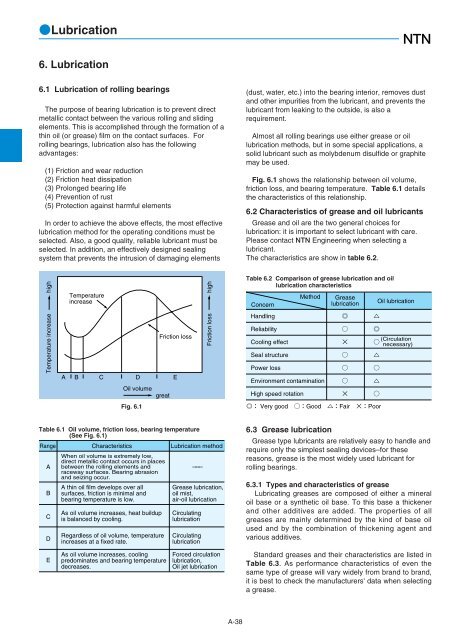NTN - Large Bearings
You also want an ePaper? Increase the reach of your titles
YUMPU automatically turns print PDFs into web optimized ePapers that Google loves.
Lubrication<br />
6. Lubrication<br />
6.1 Lubrication of rolling bearings<br />
The purpose of bearing lubrication is to prevent direct<br />
metallic contact between the various rolling and sliding<br />
elements. This is accomplished through the formation of a<br />
thin oil (or grease) film on the contact surfaces. For<br />
rolling bearings, lubrication also has the following<br />
advantages:<br />
(1) Friction and wear reduction<br />
(2) Friction heat dissipation<br />
(3) Prolonged bearing life<br />
(4) Prevention of rust<br />
(5) Protection against harmful elements<br />
In order to achieve the above effects, the most effective<br />
lubrication method for the operating conditions must be<br />
selected. Also, a good quality, reliable lubricant must be<br />
selected. In addition, an effectively designed sealing<br />
system that prevents the intrusion of damaging elements<br />
(dust, water, etc.) into the bearing interior, removes dust<br />
and other impurities from the lubricant, and prevents the<br />
lubricant from leaking to the outside, is also a<br />
requirement.<br />
Almost all rolling bearings use either grease or oil<br />
lubrication methods, but in some special applications, a<br />
solid lubricant such as molybdenum disulfide or graphite<br />
may be used.<br />
Fig. 6.1 shows the relationship between oil volume,<br />
friction loss, and bearing temperature. Table 6.1 details<br />
the characteristics of this relationship.<br />
6.2 Characteristics of grease and oil lubricants<br />
Grease and oil are the two general choices for<br />
lubrication: it is important to select lubricant with care.<br />
Please contact <strong>NTN</strong> Engineering when selecting a<br />
lubricant.<br />
The characteristics are show in table 6.2.<br />
high<br />
Temperature<br />
increase<br />
high<br />
Table 6.2 Comparison of grease lubrication and oil<br />
lubrication characteristics<br />
Concern<br />
Method<br />
Grease<br />
lubrication<br />
Oil lubrication<br />
Temperature increase<br />
A<br />
B<br />
C<br />
D<br />
Oil volume<br />
Friction loss<br />
great<br />
E<br />
Friction loss<br />
Handling<br />
Reliability<br />
Cooling effect<br />
Seal structure<br />
Power loss<br />
Environment contamination<br />
High speed rotation<br />
<br />
<br />
<br />
<br />
<br />
<br />
<br />
<br />
<br />
(Circulation<br />
necessary)<br />
<br />
<br />
<br />
<br />
Fig. 6.1<br />
Very goodGoodFairPoor<br />
Table 6.1 Oil volume, friction loss, bearing temperature<br />
(See Fig. 6.1)<br />
Range Characteristics Lubrication method<br />
A<br />
B<br />
C<br />
D<br />
E<br />
When oil volume is extremely low,<br />
direct metallic contact occurs in places<br />
between the rolling elements and<br />
raceway surfaces. Bearing abrasion<br />
and seizing occur.<br />
A thin oil film develops over all<br />
surfaces, friction is minimal and<br />
bearing temperature is low.<br />
As oil volume increases, heat buildup<br />
is balanced by cooling.<br />
Regardless of oil volume, temperature<br />
increases at a fixed rate.<br />
As oil volume increases, cooling<br />
predominates and bearing temperature<br />
decreases.<br />
<br />
Grease lubrication,<br />
oil mist,<br />
air-oil lubrication<br />
Circulating<br />
lubrication<br />
Circulating<br />
lubrication<br />
Forced circulation<br />
lubrication,<br />
Oil jet lubrication<br />
6.3 Grease lubrication<br />
Grease type lubricants are relatively easy to handle and<br />
require only the simplest sealing devices–for these<br />
reasons, grease is the most widely used lubricant for<br />
rolling bearings.<br />
6.3.1 Types and characteristics of grease<br />
Lubricating greases are composed of either a mineral<br />
oil base or a synthetic oil base. To this base a thickener<br />
and other additives are added. The properties of all<br />
greases are mainly determined by the kind of base oil<br />
used and by the combination of thickening agent and<br />
various additives.<br />
Standard greases and their characteristics are listed in<br />
Table 6.3. As performance characteristics of even the<br />
same type of grease will vary widely from brand to brand,<br />
it is best to check the manufacturers' data when selecting<br />
a grease.<br />
A-38

















